2/e
P
P T
©2007 by the McGrawHill Companies, Inc. All rights reserved.
13
Interpersonal and Collaborative Messages
©2007 by the McGrawHill Companies, Inc. All rights reserved.
McGrawHill/Irwin
Communicating Interpersonally
Interpersonal communication
◦ verbal, nonverbal, and listening interaction
3
between at least two people engaged in the co-creation of a relationship
Relational Communication
•
Interpersonal Communication and Relationships
◦
dynamic system of interaction coordinated through communication between two or more people
• Why Are Business Relationships
Important?
4
Relationship
Relational Communication
• Types of Relationships
◦ when communicators engage in contrasting
behavior in which one person controls and the other relinquishes control
Complementary relationship
◦ when the communicators mirror each other’s
behavior
5
Symmetrical relationship
Relational Communication
Some relationships are complementary in nature since one of the communicators talks more while the other listens more.
© Royalty-Free/CORBIS
6
Relational Communication
• How Do I Influence My Relationships?
• Practice Redesigning Relationships
Talk about the relationship
Negotiate new rules and structure
Change the context
7
Change your reaction pattern
Relational Communication
FIGURE 13.1 Endless Feedback Loop
8
When people interact, they repeatedly send and receive messages. These messages and reactions continually move around and between the communicato rs.
Relational Communication
• What Are the Rules for Business
Relationships?
Interactive rules
Standard rules
• Breaking the Rules
• Cross-Cultural Rules
9
Role-related rules
Communicating Nonverbally
Nonverbal communication
◦ body movements or vocal variations that
10
communicate without words
Communicating Nonverbally
What’s the Big Deal about Communicating
Nonverbally?
happens continuously
conveys 93 percent of our emotional meaning
can occur unintentionally
many cues are contextual
11
often more reliable and believable than verbal
Types of Nonverbal Communication
1. Kinesic behaviors
◦
2. Eye behavior
refers to body movements we use to communicate
◦
12
refers to eye movements that communicate emotions, facilitate and regulate conversation, and monitor reactions
Types of Nonverbal Communication
3. Paralanguage
◦ vocal sounds other than words. It is how you say something rather than what the words mean
◦
paralinguistic sounds, such as “um,” “er,” and “uh,” that fill dead air during speech
4. Chronemics
Vocal interferences
13
◦ study of how people use and perceive time
Types of Nonverbal Communication
5. Proxemics
◦ study of how people use space and distance
Intimate distance
Personal distance
Social distance
14
Public distance
Types of Nonverbal Communication
6. Haptics
◦
Nonverbal touching can communicat e a variety of messages, including a formal greeting.
© Stockbyte/PunchStoc k Images
15
involves touching behaviors
Types of Nonverbal Communication
Differences between men and women
16
Nonverbal Behavior Eye contact and gaze Facial expressions Gestures Posture Proxemic space Haptics (touch) Paralanguage
Communicating in Small Groups
• What Is a Small Group?
◦
composed of two or more interdependent people who are aware of their group membership and who communicate to accomplish common goals
• What’s the Difference between Small-
Group and Interpersonal Communication?
17
Small groups
Communicating in Small Groups
• Purposes of Business Groups and Teams
Task force
Quality circles
Steering committee
Management teams
18
Project teams
Communicating in Small Groups
• Purposes of Business
Groups and Teams (continued)
Cross-functional teams
Self-managing teams
Problem-solving teams
19
Virtual teams
The Four C’s of Effective Small Groups
FIGURE 13.2 The 4 C’s of Small Groups
20
The Four C’s of Effective Small Groups
Commitment
Cohesion
◦ members’ consistent participation on grouprelated tasks, and dedication to maintaining group values and achieving group goals
◦ establishment of harmonious and compatible
21
working relationships
The Four C’s of Effective Small Groups
Collaboration
◦ members of a team work together to
• Conflict Modification Strategies
accomplish a task
◦
problem modification techniques that groups use to resolve disputes
22
Conflict strategies
Conformity
Conformity
◦ acceptance of influence and adherence to
Groupthink
group rules
◦ when members neglect relevant news or
23
information that contradicts what the group already believes
Leadership in Groups and Teams
Leadership
◦ ability to influence people and share a vision
• Leadership in Meetings
that moves projects or the organization forward in a productive and creative way
◦
guidelines for discussion topics and time frames for goal accomplishment during meetings
24
Agendas
Leadership in Groups and Teams
• Leadership in Meetings (continued)
Task Leadership Skills
Analyzing problems
Evaluating criteria
Decision making and analyzing solutions
25
Developing group processing procedures
Leadership in Groups and Teams
• Leadership in Meetings (continued)
Relational Leadership Skills
Facilitating participation
Stimulating discussion
Coordinating group dialogue
26
Modifying and managing conflict
Leadership in Groups and Teams
• Gender Differences in Meetings
interruptions
take & hold floor
state verbal points concretely & authoritatively
confident about building arguments
27
collaboration
Technology for Groups and Teams
C-Commerce
◦
28
technology that allows companies to collaborate with customers, suppliers, and distributors to improve existing products and services and to create new products
Types of Nonverbal Communication
• Distance Business Meetings
◦ most common type of distance meeting in which
participants communicate by phone from different locations
1. Teleconferencing
◦
combines both visual and verbal communication so conference participants can see and hear each other at the same time by using a video monitor
29
2. Videoconferencing
Types of Nonverbal Communication
• Distance Business Meetings (continued)
◦
use of compact cameras and microphones attached to personal or laptop computers to send and receive audio and video messages transmitted over the Internet
30
3. Web conferencing
Questions
31





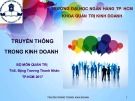
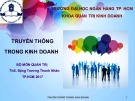
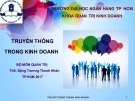
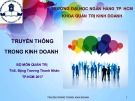

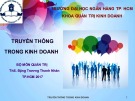


![Đề thi kết thúc học phần môn Truyền thông trong kinh doanh [năm học mới nhất]](https://cdn.tailieu.vn/images/document/thumbnail/2025/20251015/dilysstran/135x160/93281760499390.jpg)


![Bài tập nhóm truyền thông marketing tích hợp [mới nhất]](https://cdn.tailieu.vn/images/document/thumbnail/2025/20250904/hakanami1502@gmail.com/135x160/90671756969236.jpg)





![Định vị doanh nghiệp: Bài thuyết trình [Mới nhất]](https://cdn.tailieu.vn/images/document/thumbnail/2025/20250813/vuthuhuyen1407/135x160/6261755072381.jpg)



